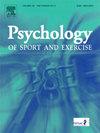Understanding motivational dynamics: Longitudinal associations between motivation and physical activity in children
IF 3.3
2区 心理学
Q2 HOSPITALITY, LEISURE, SPORT & TOURISM
引用次数: 0
Abstract
This study aims to test the longitudinal and reciprocal associations between autonomous and controlled motivation with physical activity (PA) behavior in children. These relationships were also inspected separately between boys and girls. A three-wave longitudinal study involving 502 children from primary school aged 9–11 years (Mage = 11.12; SD = 1.19; 160 boys [Mage = 10.53; SD = .53] and 131 girls [Mage = 10.49; SD = .53]), taking measures of each variable at three different times during nine months, was employed. Results indicated that boys' and girls' autonomous motivation was positively associated with higher PA behaviors over time. Furthermore, boys' and girls’ controlled motivation was positively related with PA only at Time 2 (T2); however, it was negatively related only in girls at Time 3 (T3). Also, higher PA behaviors perceived by boys and girls at Time 1 (T1) showed a positive relationship with autonomous motivation at T2, as well as PA (only perceived with boys) at T2 and autonomous motivation at T3. Only PA at T1 showed a positive and significant relationship with controlled motivation at T2 in boys. To conclude, children who are autonomously motivated tend to sustain their participation in PA longitudinally, and vice versa; those children motivated by controlled factors are promoted to exhibit diminished interest in such activities over time.
理解动机动力学:动机与儿童体育活动之间的纵向联系。
本研究旨在检验自主动机和控制动机与儿童体育活动行为之间的纵向和互惠关系。这些关系也分别在男孩和女孩之间进行了检查。一项涉及502名9至11岁小学生的三波纵向研究(Mage = 11.12;Sd = 1.19;160个男孩[法师= 10.53;SD = 0.53]和131名女孩[法师= 10.49;SD = 0.53]),在9个月内的3个不同时间对每个变量进行测量。结果表明,随着时间的推移,男孩和女孩的自主动机与更高的PA行为呈正相关。此外,男孩和女孩的控制动机仅在时间2 (T2)与PA呈正相关;然而,仅在时间3 (T3)的女孩中呈负相关。同时,男生和女生在时间1 (T1)感知到的高PA行为与T2的自主动机、T2的PA(仅男生感知)和T3的自主动机呈正相关。只有T1时的PA与T2时的控制性动机呈显著正相关。综上所述,具有自主动机的儿童倾向于长期维持其对PA的参与,反之亦然;那些受控制因素驱使的孩子随着时间的推移,对这些活动的兴趣就会减弱。
本文章由计算机程序翻译,如有差异,请以英文原文为准。
求助全文
约1分钟内获得全文
求助全文
来源期刊
CiteScore
6.40
自引率
5.90%
发文量
172
审稿时长
69 days
期刊介绍:
Psychology of Sport and Exercise is an international forum for scholarly reports in the psychology of sport and exercise, broadly defined. The journal is open to the use of diverse methodological approaches. Manuscripts that will be considered for publication will present results from high quality empirical research, systematic reviews, meta-analyses, commentaries concerning already published PSE papers or topics of general interest for PSE readers, protocol papers for trials, and reports of professional practice (which will need to demonstrate academic rigour and go beyond mere description). The CONSORT guidelines consort-statement need to be followed for protocol papers for trials; authors should present a flow diagramme and attach with their cover letter the CONSORT checklist. For meta-analysis, the PRISMA prisma-statement guidelines should be followed; authors should present a flow diagramme and attach with their cover letter the PRISMA checklist. For systematic reviews it is recommended that the PRISMA guidelines are followed, although it is not compulsory. Authors interested in submitting replications of published studies need to contact the Editors-in-Chief before they start their replication. We are not interested in manuscripts that aim to test the psychometric properties of an existing scale from English to another language, unless new validation methods are used which address previously unanswered research questions.

 求助内容:
求助内容: 应助结果提醒方式:
应助结果提醒方式:


